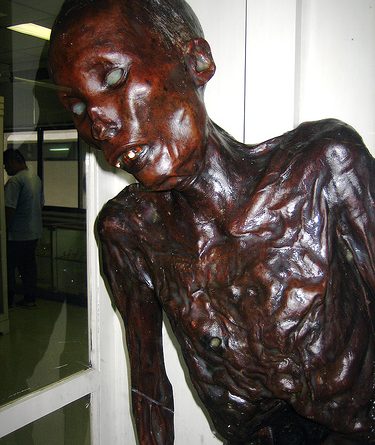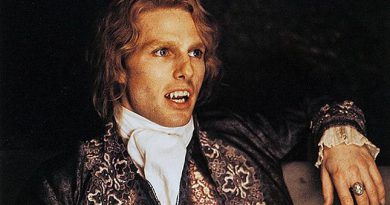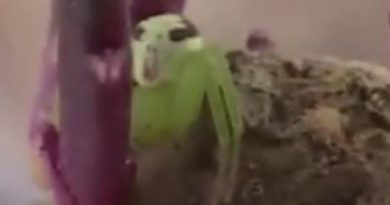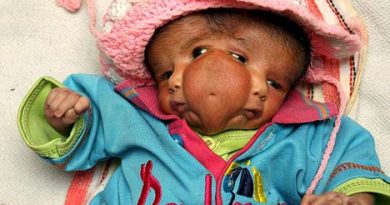Thailand Killer Cannibal See Uey Sae Ung
See more at: http://sabotagetimes.com/travel/bizarre-thailand-the-legend-of-see-uey
Dont stay out after dark or the ghost of See Uey will eat you., was a refrain in 60s Thailand, this book extract investigates the Cannibal turned supernatural legend
Think of a man so frightening that he became a legend of folklore, a boogeyman by bedside tales in Bangkok. Back in the 1960s in Thailand, many parents sat down with their children and warned them firmly: Don’t stay out after dark, or the ghost of See Uey will eat you.
The cannibal-turned-supernatural legend and movie villain was, in reality, a poor Chinese man who went on a killing spree around Bangkok and some of the nearby provinces. He had a taste for children. No one is certain, but its believed that he murdered and ate anywhere from five to eight children. Speculation also ran rife that his omnivorous diet may have included some adults that he was never charged with. Caught in the act of burning one of the corpses by the young boys father, See Uey Sae Ung was finally arrested in 1958. His confessions traumatized Thailand, birthing a bogeyman who still haunts the nations psyche. After stabbing the children in the throat, See Uey told police, he then slit open their chests and ate their hearts and livers.
When the Japanese invaded the island of Hainan in 1939, Chinese soldier See Uey Sae Ung, aka Si Oui, fought back. It was through the transgressions of war that many believed that Si Oui underwent the transformation from human to monster. Professor Somchai Pholeamke, the former head of Siriraj Hosptial’s Forensics Department in Bangkok, said, His military commanders told the troops to eat the livers of the enemy soldiers to take on their strength and power. And so, like a good soldier, Si Oui went on to devour the organs of his enemies.
Why livers? Throughout time, civilisations believed that the liver was the center of life of the body, being praised for its regenerative effects. On the battlefield, ripping out the liver of your enemy not only dehumanised them, but eating it would, to some effect, give you power.
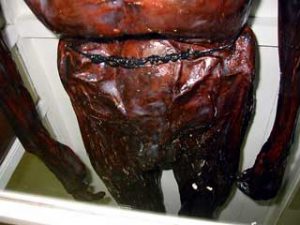
Si Oui became frequently spoke of in Thai culture, and generations of parents told their children that if they didn’t behave, the ghost of Si Oui would come and hunt them down. In somewhat of an odd twist, Si Oui became immortalised; his corpse is preserved in formaldehyde and still can be seen today in the Songkran Niyomsane Museum of Forensic Medicine in Bangkok.
A Hainanese immigrant who toiled as a coolie, rickshaw-puller and vegetable farmer after arriving in Thailand, the countrys most legendary serial slayer was a former soldier, fighting against the Japanese invaders on the Chinese island during World War II. Some believe that his bloodlust was stoked on the battlefields of Hainan province. Professor Somchai Pholeamke, the former head of Siriraj Hospitals Forensics Department, said, His military commanders told the troops to eat the livers of the enemy soldiers to take on their strength and power. Many of the Thai movies about See Uey use the battlefield as the focal point of his motivations. A scene in one such film shows the young soldier, famished and alone, after all his comrades-in-arms had been slaughtered, with nothing to eat but human carrion.
Eating livers is a ghastly rite often associated with black magic in Southeast Asia. Over the centuries it has been practiced during times of warfare to dehumanize the enemy and feed on their strength. Just as the samurais believe that a mans courage resides in his guts, which is why the ritual suicide of seppukko consists of disembowelment with a sword, the troops of the ancient Khmer empire and the more recent Khmer Rouge ate the livers of their enemies to increase their strength and stamina.
See Ueys cadaver, waxed with the preservative formalin, is the most popular exhibit at the Songkran Niyomsane Forensic Medicine Museum on the grounds of Siriraj Hospital, the countrys oldest medical facility, in Bangkok. The cannibals cockroach-brown corpse stands slumped in an upright glass casket off to one side of the room. The empty eye sockets, as well as the bullet holes left by the executioners machine-gun, have been filled in with white paraffin. Beside his final resting case there are several others occupied by killer rapists and murderers also sentenced to death.
Of the two actual skeletons in the museum, the one in a glass case belongs to the former chairman of the hospitals forensics department, Songkran Niyomsane, who founded the museum in 1965. He was a true man of forensics, said Somchai with a chuckle. He wanted the students to be able to be able to study him after he died.
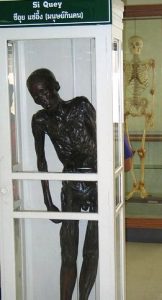
Near the preserved cadavers of the mass murderers is a glass case full of skulls with bullet holes in their foreheads. There is no signage in either English or Thai to explain this display. Somboon Thamtakerngkit, the division chief of the hospitals Forensic Pathology Department, said there is a modus operandi to the morbidity. King Rama VIII, the eldest brother of our present king, was shot in the forehead back in 1946, she said. Not much was known about entrance and exit wounds caused by gunshots then, so they used the skulls of these unclaimed bodies for tests. The results of these early shots at forensics proved that claims of suicide were skullduggery. Riddled with question marks, the case remains Thailands most contentious murder mystery.
Of the six facilities, it is the Forensic Medical Museum that draws the biggest crowds and, of all the exhibits, it is See Oueys upright casket that generates the greatest number of glares and gazes. Older Thais who grew up with admonitions from their parents that are straight out of a monstrous fairy tale are hypnotized by the cannibal. Younger Thais who have seen the movies and TV shows are baffled by his tiny size. Many of the travellers and expats look stupefied by this medieval exhibition of putting killers on public display. After all, the crimes of the serial lady-killer Ted Bundy and the cannibalistic necrophiliac Jeffrey Dahmer were much more heinous than See Ueys, but no one ever put their corpses on display.
For all the movie frames and column inches he has racked up, See Uey remains an enigma. The only information about him in the museum is a newspaper clipping in Thai, taped to the side of his final resting case, reiterating the few known facts about him his upbringing on Hainan, his days as a soldier, his alleged body count and his execution in 1958 along with a black-and-white mug shot in which the rodent-faced man is baring his teeth. But its difficult to read the expression on his face. Was he mugging for the crime photographers and living up to his reputation? Is this the glower of an extraordinarily angry and embittered man? Or does he look more like a cornered rat, baring his teeth and snarling out of fear?
To answer those questions, I spent a lot of time in Chinatown, over the course of many years, writing all sorts of features and guidebook entries about the history of the area and the exodus from China that brought in tide after tide of landed immigrants during World War II and after the country fell to the communists in 1949. An elderly woman who sold vegetables in the Old Market (little changed in the past century), told me, Theres a Thai expression about traveling with a pot and a mat to describe any trip taken on the cheap. But it actually came from the fact that those were the only two things that most of us Chinese immigrants brought to Thailand. Even thinking about that journey by boat makes me seasick: stuck in a cargo hold for months that stank of shit and vomit and piss, roaches and rats everywhere. She shuddered with disgust.
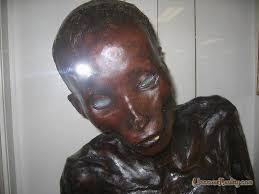
Another Chinese immigrant from Hainan, a retired police officer on active duty at the time See Uey was on the loose, spoke of the xenophobia directed at the so-called Jews of the Far East wherever they washed up after the exodus: Thailand, Malaysia, Indonesia, the United States. There are many Thai slang terms for us. Because we were seen as reds they sometimes called us pussy blood Chinks. Since the communists wanted to destroy religion and the temples we were also referred to as the Chinks who killed the temples. That one I still hear quite often, but some of the older expressions like rickshaw Chinks and human animals that were used to describe our status as the lowliest manual labourers, arent really used anymore, expect by a few older people, said Wen Liang, sitting in a shophouse that was a reconverted opium den, near the Dragon Lotus Temple in Chinatown.
As a coolie and vegetable farmer, See Uey would have also been a punching bag for many of the same jabs and swipes.
Like many people interviewed for this story, the retired cop expressed skepticism that the cannibal killed and ate as many children as he was charged with. Let me put it this way. It would not have been difficult to pin some other unsolved murders on a poor, illiterate human animal. He did confess to killing some of the children, but its possible he may have targeted some adults, too. We found a few other corpses that had been cannibalized in Bangkok around that time, but he was never charged with those crimes or confessed to them. Slowly and solemnly, the ex-cop nodded. We detectives are forever examining motives. Some of my colleagues in the police force interviewed him after he was arrested and they did not think he was insane. I have often wondered if his anger was not a more generalized rage against the world mixed with a kind of sorrow that came from knowing he would never see his homeland again. Many Chinese immigrants of the time could probably identify with those misgivings.
Read more at http://sabotagetimes.com/travel/bizarre-thailand-the-legend-of-see-uey/
